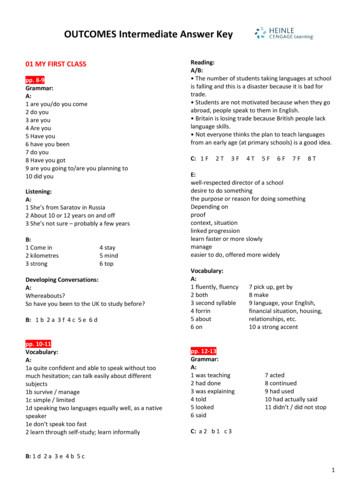What To Do When You Find A Swarm Of Honey Bees
What to dowhen you finda swarm ofhoney beesBy Emma Mullen& David Hopkins
Honey bee swarmsHoney bee swarming usually occurs on warm sunny days, most often in late spring and earlysummer in New York State. It is a natural phenomenon that allows honey bee colonies toreproduce. Under the right environmental and colony conditions, the queen leaves the hivewith 40-70% of her offspring. This group of thousands of bees temporarily cluster on a treebranch, in a bush, or on another structure, where they remain while they make a collectivedecision selecting where their new nest site will be. A swarm cluster is usually about the sizeof a soccer ball but can be larger or smaller. Typically, bees are flying to and from the cluster,which can remain in one spot for anywhere from a few hours to a few days. Once they choosetheir new home, they take off together and fly to it, possibly several miles away. While aswarm is clustered is the best time the colony can be caught by a beekeeper. Reporting aswarm should be done as soon as possible.If you spot a swarm of honey bees, please contact a beekeeper in this directory.There are over 150 beekeepers in New York who are trained to safely remove swarms.Beekeepers help assure the honey bees will find a home in an apiary rather than a farmbuilding, home, or other structure. They care for these honey bees and give them the bestchance of survival. Honey bees face many stress factors here in New York State, so calling aswarm catcher instead of a pest controller can help preserve these colonies.Honey bee swarm. Photo by David Hopkins.Beekeeper retrieving a swarm. Photo by David Hopkins.What should I do if I see a swarm?First, do not approach the swarm. Although honey bee swarms are typically very docile, thereis always a risk to being stung. Instead, it is best to observe from a distance while noting thefollowing characteristics of the swarm:1. Approximately how big is it? For example, is it the size of a grapefruit? A basketball?2. What color are the bees?3. On what structure are they clustered? How high up is the swarm?4. Do you see any nesting material, or only bees?5. How long have you noticed it has been there?
If you are able to safely do so, it is very helpful to take a photo of the swarm. Many swarmcatchers ask for a description or a photo so that they can verify that these insects are indeedhoney bees.Second, use this directory to find the swarm catchersin your county and who will visit your region. Callmore than one swarm catcher if you do not getthrough to one immediately. Because swarms candepart in as little as a few hours, time is of theessence. Offer to email or text a photo to the swarmcatcher. This will help them prepare their equipmentand strategy. It is important to discuss ahead of timewith beekeepers what you can expect of their visit,when they plan to arrive, if they will require trimmingyour vegetation, and if there is a cost associated withtheir visit.Some beekeepers remove establishedhoney bee colonies, wasp nests, and carpenter beesMany beekeepers in this list will also remove wasp nests or carpenter bees and will performextractions of nuisance honey bees. The latter is a process where a beekeeper removes anestablished honey bee colony from a structure. If a swarm decides your house walls or shedwill be a nice home, the bees will begin to build comb and live there. Beekeepers who performextractions (“cut-outs”) will remove these bees and theirnesting material. It is critical that the nesting material andhoney is removed along with the bees. If it is left there, itwill attract insect and rodent pests and will cause moistureissues in time. The directory will inform you whether thebeekeeper is skilled at performing extractions or removingwasps, in addition to catching swarms.Please refrain from spraying honey bees with pesticides. Ifextermination is absolutely required, it is prudent to askthe pest controller for the use of a vacuum hose and/or anon-toxic killing agent such as soapy water.Following an extermination, it is necessary to remove thedead bees and debris of the colony to avoid attractingfuture swarms, pests, or damaging components of thebuilding. The complexity of extractions varies. Eachsituation is unique, deserving of an individual strategy, andoften requires more than one visit from the extractor. It generally involves opening a buildingto remove the bees and debris. Some extractors repair the building afterward, while othersdo not.Photos: Beekeeper catching swarm (top). Photo by Jon Ryan. Beekeeper performing a honey bee colony extraction. Photo by Lucinda VanVleck.
Distinguishing honey bees from other insectsThere are a number of wasps and bees that are easily mistakenfor honey bees. It is important for the swarm catcher orexterminator to know the species involved. Some beekeepers inthe directory are capable of removing a variety of species.Honey bee swarms are a collection of thousands of bees thatgather in a tight cluster. These bees are brown and black in colorand are fuzzy. They have not created any nesting material. Thefollowing photos are of honey bee swarms settled on variousstructures.Honey bee (top left). Photo by Lucinda VanVleck. Honey bee swarms (bottom left, middle, and right). Left swarm photo by Emma Mullen, middle andright swarm photo by Lucinda VanVleck.If honey bees have decided to make a home of your house or shed, they will beginconstructing beeswax hexagonal cells and will fill these cells with honey, pollen, andimmature bees. These colonies are considered “established”. A beekeeper who performsextractions is needed in these cases. Honey bee colonies live in existing cavities. They do notlive in the ground and they do not create paper or mud nests.Established honey bee colony with beeswax. Photo by Lucinda VanVleck.Established honey bee colony. Photo by Lucinda VanVleck.
Wasps are often confused with bees, but they can be recognized by their different physicalappearance and their nests. Unlike honey bees, wasps are almost completely hairless. Theircoloration is typically combinations of yellow and black, white and black, or orange and black.Their families are not as large as honey bees, and can range from a few individuals tohundreds. They often live in paper nests made of a gray, papery material, in mud nests, or inthe ground. The following photos are of some wasps and their nests.Yellowjacket. Photo by Emma Mullen.Paper wasp nest. Photo by Emma Mullen.Paper wasp. Photo by Emma MullenNew York State is home to 417 species of bees! Common bees that are confused with honeybees include carpenter bees, bumble bees, or ground-nesting bees. Large carpenter bees arebig fuzzy bees, yellow and black in color, with shiny black abdomens. They drill holes in woodand nest inside these small cavities. Bumble bees are primarily yellow and black fuzzy beesand nest in the ground. Ground nesting bees live in bare ground. All of these bees pose verylittle risk of stinging; none are defensive toward humans unless they are provoked. They areall important pollinators.Bumble bee. Photo by Emma Mullen.Ground nesting bee. Photo by Chris Kitchen.Carpenter bee. Photo by Emma MullenDo you want to be added to our directory?Are you a swarm catcher, a wasp-remover, or someone who performs extractions? Join ourdirectory! Email us at dycebees@cornell.edu so we can learn more about you. We’re alwayshappy to answer your questions at this email address.
Beekeepers help assure the honey bees will find a home in an apiary rather than a farm building, home, or other structure. They care for these honey bees and give them the best chance of survival. Honey bees face many stress factors here in New York State, so calling a swarm catcher instead of a pest controller can help preserve these colonies.
work/products (Beading, Candles, Carving, Food Products, Soap, Weaving, etc.) ⃝I understand that if my work contains Indigenous visual representation that it is a reflection of the Indigenous culture of my native region. ⃝To the best of my knowledge, my work/products fall within Craft Council standards and expectations with respect to
OUTCOMES Intermediate Answer Key 01 MY FIRST CLASS pp. 8-9 Grammar: A: 1 are you/do you come . 2 do you . 3 are you . 4 Are you . 5 Have you . 6 have you been . 7 do you . 8 Have you got . 9 are you going to/are you planning to . 10 did you . Listening: A: 1 She’s from Saratov in Russia . 2 About 10 or 12 years on and off . 3 She’s not sure .
Lord, You’ve been so good to me Lord, I thank You You are my help, You meet my need Lord, I thank You You were my strength when I was weak Lord, I thank You Your love and mercy rescued me Lord, I thank You I thank You Lord Lord, I thank You I thank You Lord Lord, I thank You Every time I think of
God will answer. When you are in trouble God will be there. When you are lost God will find you. When you are afraid God will support you. May God bless you and keep you. In the plans you make, in all that you hope for, in the deep desires of your heart, God is alive and at work. When you ask for help for other people God works through you.
but you’d never say this to my face. Being proud doesn’t change that you’re a coward. I will not defend you when you attack me and you can’t undo your own doing. One day this will haunt you, come back to you, You can’t hide forever you know. You’ll have to show yourself one day and when you
You Are Special! For you created my inmost being; you knit me together in my mother’s womb.—Psalm 139:13 God made you special, distinctive, and unique and is still molding you, just like the bamboo seed. There is nobody else quite like you because you are one of a kind. He made you just the way He wanted you and loves you so much.
THE PLACES YOU'LL GO! You'll be on your way up! You'll be seeing great sights! You'll join the high fliers who soar to high heights. You won't lag behind, because you'll have the speed. You'll pass the whole gang and you'll soon take the lead. Wherever you fly, you'll be the best of the best.
ask you to swear or affirm that you will tell the truth in your testimony. v. You will offer testimony. If you have a representative, he or she will usually ask you questions relevant to your appeal. If not, you should tell the Veterans Law Judge why you believe you deserve the benefits you are seeking. v. You may submit more evidence. If you .























